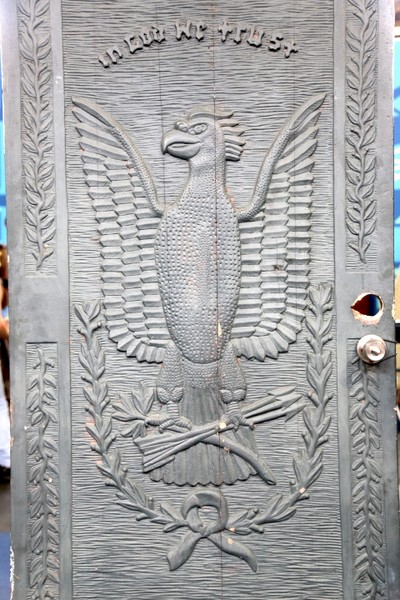Antiques Roadshow Carved Door with Morgan Dollar Eagle
The 1/29/18 PBS Antique Roadshow was taped in New Orleans in July 2017. Folk art appraiser Allan Katz completely missed that the design on this hand carved mahogany door was taken from the Morgan dollars which were made in New Orleans from 1879-1904
GUEST:
Well, it's a carved panel I picked up at one of the suburbs of New Orleans. It was offered online and I happened to run across the ad, and I saw the image of this panel and I was quite in awe of the detail of this carving, and I knew that I had to find out more about it.
APPRAISER:
How long ago was that?
GUEST:
I picked it up in April. I dabble in, I call it "junking." (chuckles) And I've been doing it for some time. It was being used as a side door to a garage, and the man couldn't use it because it was too heavy to use constantly with his children and his dog, and so he wanted enough just to buy an exterior door to put in his garage.
APPRAISER:
Well, when we take a look at it, it's monumental. And I think originally, it was, indeed, made as a door. Always difficult to tell exact age, and we tend to do so looking stylistically at the carving.
GUEST:
Okay.
APPRAISER:
First of all, it's very heavy, is it not?
GUEST:
Yeah, it is.
APPRAISER:
And when we looked at the wood, it's mahogany, and it's made in sections and pieced together. And by piecing it together, it would actually give it more strength. One of the things we see here is the word "In God we trust," and that first appeared on the two-cent coin in 1864. When we look at the eagle... (laughing) We sure have a stylized bird. And it's a little bit chicken, a little bit turkey, little bit eagle. And just the angles, and the way the bird is carved, wants to make you think that this was done possibly '20s, '30s, not 19th century. Now, I would eventually take that handle off when you're displaying it, I think it would look a lot more attractive.
GUEST:
I agree.
APPRAISER:
It's had a few coats of paint, but quite pleasant in a monochromatic tone. It's really just a wonderful, decorative piece of folk art, and it's no body of work that we know of by this particular carver. A little bit difficult to display, but I think it would look amazing if you could mount it on a wall of a home and put some light on it. So we're going to place a retail valuation of $4,000 to $6,000 on this.
GUEST:
Wow! (laughing) I wasn't going to say that, but I am impressed. I am, I am impressed.
APPRAISER:
You didn't tell me what you paid for the door.
GUEST:
It was modest. I gave the man $180 for the door. He was asking $200, and I had to drive 50 miles to get it, so he cut down $20 on it.
APPRAISER:
Okay.
GUEST:
And if you're out there, buddy, I'll give you $20 I cut from you.
APPRAISER:
(laughing)
GUEST:
Well, it'll be for sale. Because I don't want to keep it.
Comments
PS: Do you agree that blitzdude is a great guy?
Meh-
that was cool to read and different
I wouldn't be very interested in knowing the "retail" valuation. I would want to know how much cash I could get for that ugly piece of junk. The "Antiques Roadshow" is coming to my area this June and I have put my name into the ticket lottery. If I should happen to get tickets (the odds aren't good) I'm still trying to decide what to bring.
The appraiser was so close, too! He pegged the source of the "IGWT" as coming from coinage, but didn't follow the trail to the end!
Given the font of the IGWT, the wreath and bow below, and the eagle positioning....I think you nailed the source of inspiration.
If truly mahogany, I would strip it and bring out the wood beauty...and hopefully use it in the house. Like to my library....Cheers, RickO
I'd send it to PCGS and get it graded.
Pete
Interesting. I only catch AR show a few times a year, but I happened to be watching that one. The comment about the first year "In God We Trust" was added to U.S. coinage did catch my ear. The other thing that I reflected on was it being defined as "folk art." I guess part of the allure of "folk art" is that more often than not pieces of this size and vintage have long deteriorated or been trashed so that what remains gains in value. Not unlike the increased value for vintage coins based upon survival rates.
Thanks for posting.